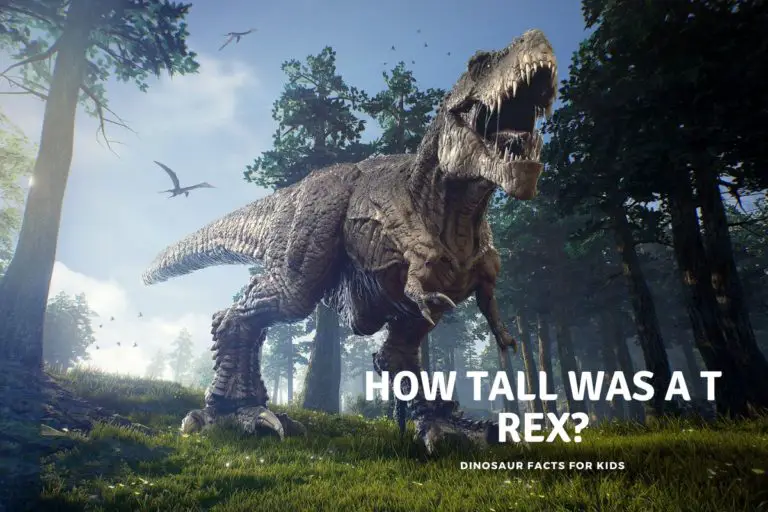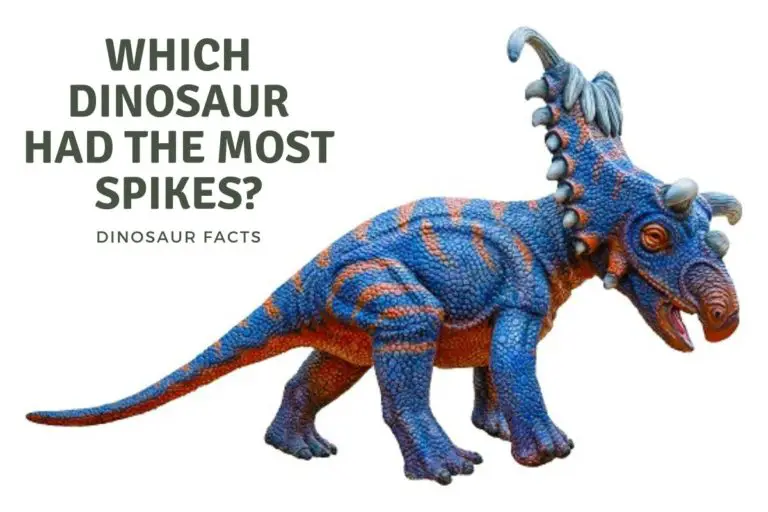How Big was Argentinosaurus?
Ever since the discovery of Argentinosaurus in 1980, and then more completely in the 1990’s the race for the title of largest ever dinosaur which was already fiercely contested heated up. There have been some pretty wild estimates about the size of Sauropods including the Argentinosaurus, and we will take a look and just how big it was likely to be here.
Argentinosaurus size estimates range from 98 to 130 feet in length ( 30 -35 metres), 68 to 105,000 kg (130,000 to 230,000 lbs) and a more stable 21 feet (7 metres) at the hip and 50-70 feet (15-21 m) to the head. Argentinosaurus is only known from limited fossils which has made estimates of its size difficult.
So while the estimates may vary, and likely fall somewhere in the middle of all these, there is no doubt it was a gargantuan dinosaur and a contender for the largest land animal of all time. We take a look at its size on this page, and also explore some comparisons and some reasons why it may have needed every foot and pound of that size to live in the environment it did.
What was the Argentinosaurus?
Although it is the current, though disputed, holder of the largest ever dinosaur title and pretty well known it is worth explaining a little about this huge animal here before we get on to what exact numbers the word ‘massive’ means.
Argentinosaurus was a massive, long-necked sauropod dinosaur that lived during the Late Cretaceous period, approximately 96.2 to 92.2 million years ago and probably before and after that time.
It was herbivorous and ate plants and trees, higher than other animals due to this massive size. it was thought to be large due to both the abundance of food and the necessity to outgrow predators of it time and location like Mapusaurus, which may ( or may not) have been a pack hunter that preyed on Argentinosaurus .
It was first discovered in 1987 by a farmer in Argentina, and excavated by the world famous paleontologist Jose bonaparte. Since then, more remains of this giant herbivore have been unearthed in various parts of the country. It has been classified as a titanosaur, and the clue is in the name it really was a titan. Which is what we will look at next.
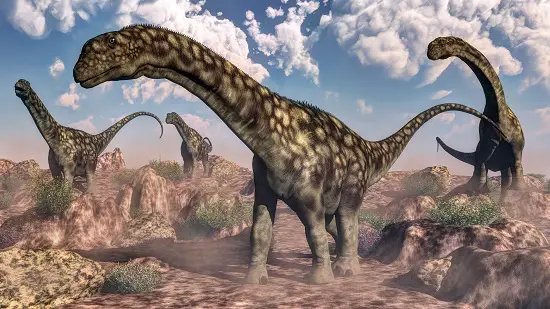
Size of Argentinosaurus: length, weight, and height.
| Dinosaur Name | Length (m) | Length (ft) | Height (m) | Height (ft) to hip | Weight (kg) | Weight (lbs) | Lived During |
|---|---|---|---|---|---|---|---|
| Argentinosaurus | 30-40 | 98-130 | 7-8 | 23-26 | 60,000-105,000 | 130,000-230,000 | Late Cretaceous 97-92 mya |
The actual estimated size of Argentinosaurus has changed so often in the 40 years since that first discovery it is incredibly difficult to be 100% accurate and to keep up! . We have included the ranges in the table above.
However a length of over 100 feet and a weight of over 80,000 Kg ( 170,000 lbs) occupy the middle ground.
The exact size of Argentinosaurus is made difficult to determine due to the limited fossil evidence available. There are only around 13 fossilized bones that have been discovered to date and although science has certainly got better at estimating the size of dinosaurs it still needs evidence to do so and in Argentinosaurus case this is in short supply ( about the only thing short about this dinosaur!)
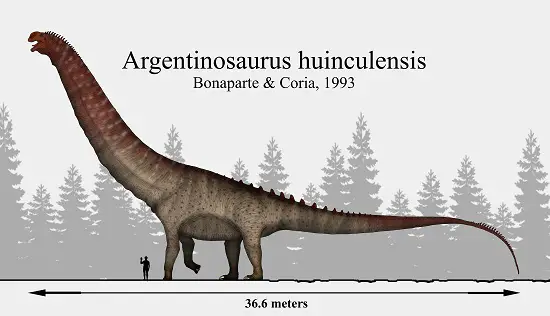
Length of Argentinosaurus
As we mentioned above there have been some pretty wild estimates on all aspects of the Argentinosaurus;s length and when first discovered it was put at around 98 to 115 feet (30-35 metres long.
This then varied over the years for example on 2006 it was suggested a length of 30 metres (98 feet) then in 2008 it was 33 metres (108 feet) and most recently in 2019 it was estimated at 115 feet (35 metres or even longer!)
Weight of Argentinosaurus
The only thing more varied about argentinosaurus length estimates are the weight ones. This has been born of which other sauropods they compare its anatomy or body shape to. Shortly after it was discovered it was suggested it may have been 80,000 to 100,000 kg ( 170 – 220,000 lbs, )
it then varied over the years from 60,000 kg all the way to 105,000 kg ( 130,000 lbs to 230,000 lbs) and most recently in 2020 it has been scaled down to about 75,000 kg or 170,000 Lbs. While still absolutely massive, it is still shy of the over 300,000 lbs that a blue whale can weigh.
Height of Argentinosaurus
Less controversial is the height, to the hip at least, of the Argentinosaurus. An Estimate of over 7 metres (22 feet) is fairly universally accepted. Though the hips were lower than the shoulders as with many Sauropods.
While of course with its head held high this could be over 50-60 feet plus tall – it had to get those tall tree tops somehow! Some estimates even put it as high as 70 feet or 21 metres. Just to be clear the average 2 story house is between 5 and 6 metres tall so we are talking about 4-5 houses tall, or about 4 or 5 T-Rex even if it was standing on its tip toes!
Comparison of Argentinosaurus with other sauropods
While Argentinosaurus is considered one of the largest dinosaurs ever to have lived, There are plenty of super sized sauropods to give it competition, as wiki states below.
Puertasaurus, Futalognkosaurus, Dreadnoughtus, Paralititan, “Antarctosaurus” giganteus, and Alamosaurus have all been considered to be comparable in size with Argentinosaurus by some studies
Wikipedia

And the image you can see above shows some of the contested sauropods ( ones that can not be 100% proved to have existed just yet) and how it would stack up next to them.
Compared to other sauropods that can be proven to have existed and can whose size can be reasonably estimated, like Apatosaurus, Brachiosaurus, Diplodocus and Dreadnoughtus, Argentinosaurus was larger in size, but shared many similar anatomical features.
In fact all sauropods had small heads, long necks, and long tails, and were adapted to herbivorous diets and while there would be certainly differences between them this body shape was common amongst all of them.
| Dinosaur Name | Length (m) | Length (ft) | Hip Height (m) | Hip Height (ft) | Weight (kg) | Weight (lbs) | Lived During |
|---|---|---|---|---|---|---|---|
| Argentinosaurus | 30-35 | 98-131 | 7-8 | 23-26 | 60,000-100,000 | 130,000-220,000 | Late Cretaceous |
| Dreadnoughtus | 26-28 | 85-95 | 6-7 | 20-23 | 22,000 – 48,000+ | 50,000-110,000 | Late Cretaceous |
| Brachiosaurus | 18-22 | 59-72 | 6-7 | 20-23 | 28,000-58,000 | 60,000-120,000 | Late Jurassic |
| Diplodocus | 30 | 95 | 5-7.5 | 15-25 | 23,000- | 50,000lbs | Late Jurassic |
| Apatosaurus | 21-23 | 69-75 | 5-6 | 13-16 | 16,000 – 22,000 | 35,000-49,000 | Late Jurassic |
| Tyrannosaurus rex | 12-13 | 39-41 | 4-6 | 13-20 | 5,000-8,000 | 11,000-18,000 | Late Cretaceous |
These dinosaurs were some of the largest creatures to have ever existed, with Argentinosaurus and Dreadnoughtus being among the largest in terms of weight, and dreadnoughtus fossils being greater in number with about 70% of the dinosaur being discovered fossilized so far.
However there are recent reports of a possible even larger dinosaur being excavated in Argentina that may out weigh and out long ( of that’s a thing) at the moment which you can read about here.
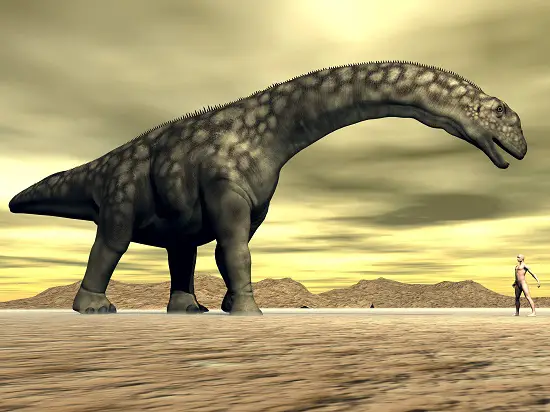
Why Was Argentinosaurus So big?
There are a few theories on why the argentinosaurus evolved to be so big and we highlight the three main ones below.
Diet
As a herbivore, Argentinosaurus likely fed on plants such as ferns, cycads, and conifers. It would have had to eat vast amounts of vegetation to sustain its massive body size.
Argentinosaurus lived in the forests of what is now Argentina, which were much wetter and more humid during the Late Cretaceous period than they are today and in fact the fossils were found in areas with evidence of rivers and wetlands.
Habitat
The Patagonian region where Argentinosaurus lived was characterized by grasslands, forests, rivers and plenty of evidence of plants, which provided plenty of food for herbivorous dinosaurs like Argentinosaurus.
There were plenty of other dinosaurs in the area, not just predators that we look at below, but also other dinosaurs like Overoraptor, Skorpiovenator and even other sauropods like Choconsaurus and Cathartesaura although they were much smaller and would not have likely competed for the same food.
Predators
As unlikely as it may seem due to its massive size Argentinosaurus was possibly on the menu for some species of carnivorous dinosaurs that lived at the same time, and its size would be a deterrent for one dinosaur but maybe not if they did actually hunt in packs as has been suggested. You can check out the video below for some more information on that.
The two likely candidates, and really the only two big enough to take on a dinosaur of the size of Argentinosaurus were the Giganotosaurus and Mapusaurus, which lived in the same area around the same time. These may have preyed on old, sick or young Argentinosaurus as well.
How Do We Know How Big Argentinosaurus was?
The size of Argentinosaurus can be estimated based on the fossils that have been found and there are only a few of those! Because no complete skeleton has been discovered, its size has been estimated based on the size of other dinosaurs like Patagotitan and Dreadnoughtus.
Bone Measurements
One of the first methods used to estimate the size of Argentinosaurus is the size of its bones. The thigh bone (femur) of Argentinosaurus is estimated to be around 4 meters (13 feet) long. Using mathematical formulas, scientists can estimate the total length and weight of the dinosaur based on the size of its bones.
Computer modelling of Dinosaurs
They then take these measurements and put them through computer programs and simulations that can be adjusted. These will offer estimates on the size of the dinosaur depending on the data used.
Comparisons with other animals and Dinosaurs
This data is often used from other similar types of dinosaurs that have more complete fossils, and it is where it can get a little risky. Not all dinosaurs were cookie cuttered out, even if they were the same group or family and giving a diplodocus the bulk of dreadnoughtus or brachiosaurus for example would have it the largest dinosaur. So care has to be taken when making these comparisons.
We have a series of articles on How Big Dinosaurs were, including sauropods and carnivores, and you can follow the links below to check out the size of other popular dinosaurs. We are expanding this section on a regular basis.
And if you wanted to know some of the smallest dinosaurs ever you can check out the article on the site as well. As although dinosaurs are often thought to be huge monstrous animals there were plenty of small ones as well and we take a look at them on the link above.
Conclusion
Argentinosaurus was a certainly a massive dinosaur that lived during the Late Cretaceous period in what is now Argentina. whether it was the biggest is still up for intense debate but general consensus is that it likely was the largest.
However as we discuss in our long neck dinosaur article and the amphicoelias article there are suggestions there may have been even larger dinosaurs at one stage. Its worth checking that out.
However, at likely over 100 feet in length, 75-80,000 kg and at least 7 metres tall at the hips it all becomes just a jumble of numbers at some point, and Argentinosaurus may or not be the biggest dinosaur of all time, but we can easily agree it was absolutely huge!
Update: if you check out this link its days at the top of that largest dinosaur chart may be numbered….
References
- https://www.britannica.com/list/titanosaurs-8-of-the-worlds-biggest-dinosaurs#:~:text=Although%20no%20complete%20skeletons%20of,(99%20to%20110%20tons).
- https://www.nationalgeographic.com/science/article/biggest-dinosaur-ever-maybe-maybe-not
- https://en.wikipedia.org/wiki/Argentinosaurus
- https://phys.org/news/2021-01-gigantic-dinosaur-unearthed-argentina-largest.html
Hi, I am Roy Ford a General Studies and English Teacher who has taught all over the world. What started as a fossil collection became a great way to teach, motivate and inspire students of all ages and all over the world about dinosaurs and from that and children’s love of dinosaurs came the site dinosaur facts for kids, a resource for all ages.

